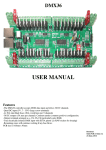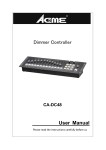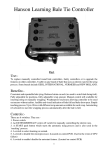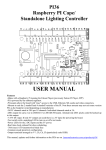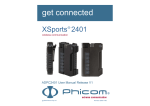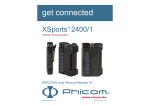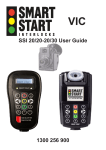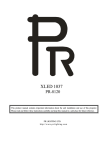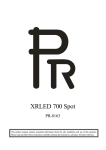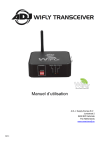Download Mega60 User Manual 1.3
Transcript
AAHMEGA60 USER MANUAL Features -The AHMEGA60 controller accepts DMX data input and drives 60 DC channels. -Quad DC input (5V - 40V) (large screw terminals) -4x 30A mini blade fuses (30A overall max per 15 channels) -Adjustable output voltage per zone. Pulse width modulated output voltage emulation -60 DC outputs (5A max per channel). Common anode (common positive) configuration. -Output terminals arranged as V+, Ch, Ch, Ch (particularly suits RGB) -True electrically isolated DMX input (2x RJ45 sockets for looping) -ESTA or LOR network wiring configuration can be selected via on board jumpers adjacent to RJ45 DMX sockets -Remaining zones will continue working if any fuse blows PCB size is 238mm x 115mm Revision 3 Suits PCB revision 1.2 2-November-2012 INDEX CONNECTIONS . . . . . . . . . . . . . . . . . . . . . . . . . . . . . . . . . . . . . . . . . . . . . . . . . . . . . . . . . . . . . . . . . . -3Dmx Data . . . . . . . . . . . . . . . . . . . . . . . . . . . . . . . . . . . . . . . . . . . . . . . . . . . . . . . . . . . . . . . . . . . -3DC Power Input . . . . . . . . . . . . . . . . . . . . . . . . . . . . . . . . . . . . . . . . . . . . . . . . . . . . . . . . . . . . . . -3Dimmer Outputs . . . . . . . . . . . . . . . . . . . . . . . . . . . . . . . . . . . . . . . . . . . . . . . . . . . . . . . . . . . . . . -3USB Connector . . . . . . . . . . . . . . . . . . . . . . . . . . . . . . . . . . . . . . . . . . . . . . . . . . . . . . . . . . . . . . -4ICSP Connector . . . . . . . . . . . . . . . . . . . . . . . . . . . . . . . . . . . . . . . . . . . . . . . . . . . . . . . . . . . . . . -4- USING THE AAHMega60 . . . . . . . . . . . . . . . . . . . . . . . . . . . . . . . . . . . . . . . . . . . . . . . . . . . . . . . . . . -4Status Leds . . . . . . . . . . . . . . . . . . . . . . . . . . . . . . . . . . . . . . . . . . . . . . . . . . . . . . . . . . . . . . . . . . -4Start Channel . . . . . . . . . . . . . . . . . . . . . . . . . . . . . . . . . . . . . . . . . . . . . . . . . . . . . . . . . . . . . . . . -4Test Mode . . . . . . . . . . . . . . . . . . . . . . . . . . . . . . . . . . . . . . . . . . . . . . . . . . . . . . . . . . . . . . . . . . -4Zone Volts . . . . . . . . . . . . . . . . . . . . . . . . . . . . . . . . . . . . . . . . . . . . . . . . . . . . . . . . . . . . . . . . . . -4Mode Jumpers . . . . . . . . . . . . . . . . . . . . . . . . . . . . . . . . . . . . . . . . . . . . . . . . . . . . . . . . . . . . . . . -4Dmx start address table . . . . . . . . . . . . . . . . . . . . . . . . . . . . . . . . . . . . . . . . . . . . . . . . . . . . . . . . -5- CONNECTION EXAMPLES . . . . . . . . . . . . . . . . . . . . . . . . . . . . . . . . . . . . . . . . . . . . . . . . . . . . . . . . -6- WARRANTY . . . . . . . . . . . . . . . . . . . . . . . . . . . . . . . . . . . . . . . . . . . . . . . . . . . . . . . . . . . . . . . . . . . . -7- ENQUIRIES/REPAIRS . . . . . . . . . . . . . . . . . . . . . . . . . . . . . . . . . . . . . . . . . . . . . . . . . . . . . . . . . . . . -7- Connections Dmx Data There are 2 RJ45 dmx sockets on the board. These are designed for loop in and loop out. If the AAHMega60 is the last dmx device on the dmx cable then the signal should be terminated with the termination jumper. Basically if only 1 cable is plugged in to the dmx sockets then the termination jumper should be installed. If both sockets are used then the termination jumper should be left off. There are 2 sets of jumpers adjacent to the dmx sockets. These allow for connection to either ESTA or Light-ORama (LOR) networks. If the next device connected to a given socket is wired according to the ESTA standard then the 3 jumpers would be installed in the ESTA network position. If the next device is a LOR device (USB dongle, CTB16PC etc) then the 3 jumpers would be installed in the LOR position. The relative positions for the 2 networks is marked on the pcb. DC Power Input The 4 large 2 way green connectors are the DC inputs from your power supply. Each of the 4 zones of 15channels can use a separate power supply or you can feed them all from one common power supply. Separate wiring (back to the power supply) for each of the zones is recommended to minimise voltage drop. The +V terminals are positive and the -V terminals are negative. Any DC voltage in the range of 5V to 40V can be used. The negative (-V) terminals are commoned between the 4 zones so this must be taken into account when wiring up to the power supply/supplies. Each of the 4 zones has a standard ATX (automotive) fuse adjacent to the power terminals. The AAHMega60 comes supplied with 10A fuses fitted. Fuses up to 30A can be used. It is recommended changing the fuse to the closest size for the total current that the zone will be supplying. It is recommended that the dmx cables not be connected when changing from LOR to ESTA as an accidental short circuit may damage the dmx transmitter. Dimmer Outputs There are 60 channel outputs; 30 per side with each side divided into 2 zones. Each side can be run at the same, or a different supply voltage. Any DC voltage in the range of 5V to 40V can be used for each of the banks. The maximum load per channel is 5 Amps, but remember that the overall limit per bank/zone of 15 outputs is 30 Amps. This means that you can't turn on all 15 outputs of a zone with the maximum load. In reality, this should not be a problem as most loads will be less than 2 Amps. There are 60 dimmer outputs which are in banks (zones) of 15 with each zone of 15 fused separately. Each group of 3 outputs is grouped into 4 terminals. These are the 3 outputs and a common positive. RGB lights with a single common anode should have the common wire connected to the terminal +V (the 4 banks have common +ve terminals +V1, +V2, +V3 and +V4) and the red, green and blue wires to channels 1,2,3 (or 4,5,6 etc). The order and specific channels is actually dependant on what is configured in your sequencing software. For lights that have single colours (or single channels) per pair of wires then 1 wire gets connected to the +V and 1 gets connected to the channel output. For led lights which require the polarity to be around the right way then the anode (positive) gets connected to +V and the cathode (negative) goes to the channel. For lights that do not have three channels commoned then 3 wires will be joined and fitted to the +V for the 3 channels. See the Connection Examples section for the various methods of connecting lights. -3- USB Connector A USB connector is provided for program (firmware) updates. This currently has not been enabled in the firmware. ICSP Connector A ICSP (in circuit serial programming) connector is provided for initial programming of the microprocessor and for program (firmware) updates. USING THE AAHMega60 Status Leds There are 3 small LEDs near the centre of the PCB adjacent to the micro. Red led-Power, Blue led-Mode, Green led-Data -Red led 5V power -(MODE) Blue led flashing slowly (1Hz ). (DATA) -(MODE) Blue led flashing 10Hz. (DATA) -(MODE) Blue led on solid. (DATA) Green led off. Test mode Green led off. Address setting error Green led flashing 10 Hz. Normal run mode. Dmx packets being received -(MODE) Blue led on solid. (DATA) Green led flashing at 1Hz. Incomplete dmx packets being received. At least the first dmx packet is received but there is a problem with the stream before all 60 channels have their data. All outputs will be turned off. This error has been disabled on firmware version 1.2 -(MODE) Blue led on solid. (DATA) Green led off. No dmx data Test mode takes precedence over normal running so errors/status message other than test mode won’t be displayed if in test mode. Start Channel The start channel is set via 9 dipswitches. The channel is set in binary by turning on the relevant switches. DMX addresses can be anywhere between 1 and 512. The address of the AAHMega60 can be anywhere in the range of 1 to 453 (a start address of 453 uses the addresses from 453 to the maximum 512). If the address is set outside of this range an error is indicated via the 2 status leds. See Status Leds. The start channel can be changed at any time. The start address can be calculated by adding up the totals for the switches that are on. For example 64 + 16 + 1 would give a start address of 81. A table is provided later in the manual that lists the dmx start addresses. Test Mode There is a switch on the same bank of switches which places the control into a test mode. In this mode a test program runs and all 60 outputs are cycled through. This mode allows for soak testing of lights without the need for a source of dmx data. The control will cycle through 12 modes of testing from 1 led on at a time, through all reds on, all greens etc. The mode jumpers will change the test mode in later firmware revisions. Zone Volts Each of the 4 zones on the pcb has a 4 way bank of jumpers that allow the apparent output voltage for that zone to be altered. With this feature a common power supply for the entire board can power up to 4 different voltages. The microprocessor measures the input voltage of the zone and adjusts the output so that it matches what is set on the jumpers. The jumper settings are 5V, 12V, 24V, 32V and when no jumper is installed the output voltage is the same as the input voltage. The peak voltage on the output is the same as the input voltage so any lights with electronics in them (like ACL strobes) MUST NOT be used on other than 100% (usually with 5V supply) as the electronics within them are not rated to high voltages. The output voltage jumpers can be changed at any time but due to the risk to the lights of having too high an output voltage it is recommended to either set the jumpers while the unit is powered down or while the lights are turned off. Note:- It isn’t actually 5V DC (12V, 24V or 32V) but is actually a pulse width modulated output that have an average or RMS output voltage of 5V (12V, 24V or 32V). The output voltage cannot be increased and if the jumpered voltage is set to higher than the supply voltage then the control outputs the supply voltage. Mode Jumpers There is a jumper bank on the pcb with 4 possible jumper positions. These jumpers are for possible further firmware features for the pcb. These features include changing test modes. -4- Dmx start address table for AAHMega60. Switches are from left to right (on Dipswitch they are labelled as 2 to 10, on PCB they are marked 256, 128 ....... 1 in binary address sequence). Zeroes indicate the switch is off (down). Ones indicate the switch is on (up). First column is the start address and the second column is the 9 address switches. 1 2 3 4 5 6 7 8 9 10 11 12 13 14 15 16 17 18 19 20 21 22 23 24 25 26 27 28 29 30 31 32 33 34 35 36 37 38 39 40 41 42 43 44 45 46 47 48 49 50 51 52 53 54 55 56 57 58 59 60 61 62 63 64 000000001 000000010 000000011 000000100 000000101 000000110 000000111 000001000 000001001 000001010 000001011 000001100 000001101 000001110 000001111 000010000 000010001 000010010 000010011 000010100 000010101 000010110 000010111 000011000 000011001 000011010 000011011 000011100 000011101 000011110 000011111 000100000 000100001 000100010 000100011 000100100 000100101 000100110 000100111 000101000 000101001 000101010 000101011 000101100 000101101 000101110 000101111 000110000 000110001 000110010 000110011 000110100 000110101 000110110 000110111 000111000 000111001 000111010 000111011 000111100 000111101 000111110 000111111 001000000 65 66 67 68 69 70 71 72 73 74 75 76 77 78 79 80 81 82 83 84 85 86 87 88 89 90 91 92 93 94 95 96 97 98 99 100 101 102 103 104 105 106 107 108 109 110 111 112 113 114 115 116 117 118 119 120 121 122 123 124 125 126 127 128 001000001 001000010 001000011 001000100 001000101 001000110 001000111 001001000 001001001 001001010 001001011 001001100 001001101 001001110 001001111 001010000 001010001 001010010 001010011 001010100 001010101 001010110 001010111 001011000 001011001 001011010 001011011 001011100 001011101 001011110 001011111 001100000 001100001 001100010 001100011 001100100 001100101 001100110 001100111 001101000 001101001 001101010 001101011 001101100 001101101 001101110 001101111 001110000 001110001 001110010 001110011 001110100 001110101 001110110 001110111 001111000 001111001 001111010 001111011 001111100 001111101 001111110 001111111 010000000 129 130 131 132 133 134 135 136 137 138 139 140 141 142 143 144 145 146 147 148 149 150 151 152 153 154 155 156 157 158 159 160 161 162 163 164 165 166 167 168 169 170 171 172 173 174 175 176 177 178 179 180 181 182 183 184 185 186 187 188 189 190 191 192 010000001 010000010 010000011 010000100 010000101 010000110 010000111 010001000 010001001 010001010 010001011 010001100 010001101 010001110 010001111 010010000 010010001 010010010 010010011 010010100 010010101 010010110 010010111 010011000 010011001 010011010 010011011 010011100 010011101 010011110 010011111 010100000 010100001 010100010 010100011 010100100 010100101 010100110 010100111 010101000 010101001 010101010 010101011 010101100 010101101 010101110 010101111 010110000 010110001 010110010 010110011 010110100 010110101 010110110 010110111 010111000 010111001 010111010 010111011 010111100 010111101 010111110 010111111 011000000 193 194 195 196 197 198 199 200 201 202 203 204 205 206 207 208 209 210 211 212 213 214 215 216 217 218 219 220 221 222 223 224 225 226 227 228 229 230 231 232 233 234 235 236 237 238 239 240 241 242 243 244 245 246 247 248 249 250 251 252 253 254 255 256 011000001 011000010 011000011 011000100 011000101 011000110 011000111 011001000 011001001 011001010 011001011 011001100 011001101 011001110 011001111 011010000 011010001 011010010 011010011 011010100 011010101 011010110 011010111 011011000 011011001 011011010 011011011 011011100 011011101 011011110 011011111 011100000 011100001 011100010 011100011 011100100 011100101 011100110 011100111 011101000 011101001 011101010 011101011 011101100 011101101 011101110 011101111 011110000 011110001 011110010 011110011 011110100 011110101 011110110 011110111 011111000 011111001 011111010 011111011 011111100 011111101 011111110 011111111 100000000 257 258 259 260 261 262 263 264 265 266 267 268 269 270 271 272 273 274 275 276 277 278 279 280 281 282 283 284 285 286 287 288 289 290 291 292 293 294 295 296 297 298 299 300 301 302 303 304 305 306 307 308 309 310 311 312 313 314 315 316 317 318 319 320 100000001 100000010 100000011 100000100 100000101 100000110 100000111 100001000 100001001 100001010 100001011 100001100 100001101 100001110 100001111 100010000 100010001 100010010 100010011 100010100 100010101 100010110 100010111 100011000 100011001 100011010 100011011 100011100 100011101 100011110 100011111 100100000 100100001 100100010 100100011 100100100 100100101 100100110 100100111 100101000 100101001 100101010 100101011 100101100 100101101 100101110 100101111 100110000 100110001 100110010 100110011 100110100 100110101 100110110 100110111 100111000 100111001 100111010 100111011 100111100 100111101 100111110 100111111 101000000 321 322 323 324 325 326 327 328 329 330 331 332 333 334 335 336 337 338 339 340 341 342 343 344 345 346 347 348 349 350 351 352 353 354 355 356 357 358 359 360 361 362 363 364 365 366 367 368 369 370 371 372 373 374 375 376 377 378 379 380 381 382 383 384 101000001 101000010 101000011 101000100 101000101 101000110 101000111 101001000 101001001 101001010 101001011 101001100 101001101 101001110 101001111 101010000 101010001 101010010 101010011 101010100 101010101 101010110 101010111 101011000 101011001 101011010 101011011 101011100 101011101 101011110 101011111 101100000 101100001 101100010 101100011 101100100 101100101 101100110 101100111 101101000 101101001 101101010 101101011 101101100 101101101 101101110 101101111 101110000 101110001 101110010 101110011 101110100 101110101 101110110 101110111 101111000 101111001 101111010 101111011 101111100 101111101 101111110 101111111 110000000 385 386 387 388 389 390 391 392 393 394 395 396 397 398 399 400 401 402 403 404 405 406 407 408 409 410 411 412 413 414 415 416 417 418 419 420 421 422 423 424 425 426 427 428 429 430 431 432 433 434 435 436 437 438 439 440 441 442 443 444 445 446 447 448 110000001 110000010 110000011 110000100 110000101 110000110 110000111 110001000 110001001 110001010 110001011 110001100 110001101 110001110 110001111 110010000 110010001 110010010 110010011 110010100 110010101 110010110 110010111 110011000 110011001 110011010 110011011 110011100 110011101 110011110 110011111 110100000 110100001 110100010 110100011 110100100 110100101 110100110 110100111 110101000 110101001 110101010 110101011 110101100 110101101 110101110 110101111 110110000 110110001 110110010 110110011 110110100 110110101 110110110 110110111 110111000 110111001 110111010 110111011 110111100 110111101 110111110 110111111 111000000 449 450 451 452 453 454 455 456 457 458 459 460 461 462 463 464 465 466 467 468 469 470 471 472 473 474 475 476 477 478 479 480 481 482 483 484 485 486 487 488 489 490 491 492 493 494 495 496 497 498 499 500 501 502 503 504 505 506 507 508 509 510 511 111000001 111000010 111000011 111000100 111000101 111000110 111000111 111001000 111001001 111001010 111001011 111001100 111001101 111001110 111001111 111010000 111010001 111010010 111010011 111010100 111010101 111010110 111010111 111011000 111011001 111011010 111011011 111011100 111011101 111011110 111011111 111100000 111100001 111100010 111100011 111100100 111100101 111100110 111100111 111101000 111101001 111101010 111101011 111101100 111101101 111101110 111101111 111110000 111110001 111110010 111110011 111110100 111110101 111110110 111110111 111111000 111111001 111111010 111111011 111111100 111111101 111111110 111111111 Note 1:- Many DMX devices use the reverse order. The AAHMega60 uses the order as would be converted and shown on a calculator, computer etc. Note 2:-Dipswitch 1 is used to turn on and off the test mode. -5- Faultfinding Fault Solution/solutions Power Led (red led) not lit -Fuse/s blown (note the control only needs power to 1 zone for power led to be on and for that zone to work). Check fuses -Power supply faulty or not turned on. -Power supply section of pcb damaged. No user repairable parts. Return for repair 1 or more Zones not working -Fuse for that zone is blown, power supply powering that Zone is faulty or there is a wiring fault Channel failing to turn on -Mosfet transistor has been damaged. Can be replaced but warranty may be voided. The mosfet must be replaced with the exact same type to ensure correct operation -PCB track has been burnt out. Should be evident if bottom of pcb is inspected Channel turned on all the time -Mosfet transistor has been damaged. Can be replaced but warranty may be voided. The mosfet must be replaced with the exact same type to get correct operation No DMX signal -Jumpers on wrong network setting -Jumpers installed in the wrong orientation -Termination jumper is installed when both DMX sockets are in use -No data is being sent. Check software, dongle, cable etc -DMX (RS485) receive IC is damaged. IC is socketed for easy replacement Fuse blowing -Fuse selection too low for lights that are connected -1 or more lights connected have short circuited wires Connection Examples Typical connection arrangement showing 3 leds and a 12V power supply. The lights can be single colour, multicolour, RGB or whatever. For individual lights with 2 wires the positive wires would be joined and connected to the +V terminal. If only 5V lights were used on Zone 1 and a 12V (or any voltage higher than 5V) is used then by setting the Zone Volts on zone 1 can be set to 5V and the control will limit the output voltage to 5V. Note:- It isn’t actually 5V DC but is actually a pulse width modulated ouput that have an average or RMS output voltage of 5V. Connection example showing channel 1 connected to a second power supply. This method is used where lights other than the main power supply voltage is needed. This method can be used for ACL strobes or similar devices. The primary power supply powering the AAHMega60 needs to be in the range of 5V to 40V DC. The secondary power supply can be any voltage up to a maximum of 60V DC. This method can also be used if an output is used to control a relay at a voltage other than the supply voltage. As it possible to run the Mega60 off up to 4 different power supplies a light on 1 zone can be powered by the supply on another zone. DO NOT use this method if outputs on a specific zone have reduced output voltages via the Zone Volts jumpers. Relays should not be connected to outputs that have reduced voltages either. Firmware Updates Firmware update can be loaded via the onboard USB socket or if necessary through the ICSP header with a Pickit3 pic programmer. Pin 1 of the ICSP header is marked on the pcb and is shown to the right. Ensure the pin 1 of the header is aligned with pin 1 of the programmer. If the firmware is being updated it is recommended to remove the fuses of any channels that are dimmed down to less than 100% with the Zone Volts jumpers as there is a possibility that during the firmware update process the leds may be turned on with 100% voltage. Under normal circumstances all leds are turned off and should remain off during the firmware update process. -6- Plug your PicKit 3 into a spare USB port, then start MPLAB. Once it has loaded, click Configure > Select Device to bring up the device selection window. From the device drop-down list, select PIC18F4455 and click OK. A dialog saying "New firmware must be downloaded for PicKit 3 to work with the part selected." may pop up at this stage. If it does, click OK and wait for MPLAB to download the programming firmware to the Pickit 3. You will see some activity in the PicKit 3 tab of the output window for up to a minute or so. When MPLAB is ready you will see "PicKit 3 Connected" and possibly an error stating "PK3Err0045: You must connect to a target device to use Pickit 3". This is not a problem and just a warning that the PicKit 3 cannot "see" the chip yet. Then, click File > Import and browse to the MEGA60 1.2 HEXFILE.hex file (latest version at time of writing) and click Open. The last line of the build tab of the output window should read "Loaded C:\...MEGA60****.HEX." Now, connect the PicKit 3 the 6 pin ICSP header next to the micro. Make sure the arrows on the Pickit 3 and the 6 pin header are aligned. Then power up the DC48. The PicKit 3 tab of the output window should now read "Target Detected”. Click Programmer > Program to initiate the ICSP operation. The PicKit 3 tab of the output window will show "Programming...", then "Programming/Verify complete" once it is done. Disconnect the PicKit 3. The PicKit 3 tab of the output window will show "Target Removed". Warranty This dmx light controller is covered by a warranty for a period of 12 months from the time of purchase. The warranty covers only faulty material and workmanship if properly setup and operated in accordance with the specifications and setup sections of this document. The repair and or replacement of this controller will only be at the workshop of Alan Hanson. The cost of freight to/from will be borne by the user. The warranty does not cover damage to the controller due to misuse i.e.. shorting of outputs, connecting AC supply, connecting a supply higher than the rated voltage The controller is supplied as is. Alan Hanson and Hanson Electronics reserves the right to make changes to the firmware, specifications and the design without notification. Misuse, using this for other than its designed use, water damage, mechanical damage or attempting to modify or repair your controller will void this warranty. Alan Hanson and Hanson Electronics shall not be liable for any incidental damage, inconvenience, rental, loss of profits or any other loss due to the unsuitability, failure or use of this controller. If the user does not agree to these terms the cost of the product (minus freight) will be refunded on the return of the product. The controller must be in unused condition and must be returned within 14 days. Please return this controller with a copy of your invoice if it develops a fault. Any controller returned without a copy of the invoice will be charged at a standard repair rate. The warranty does not cover freight. Mounting standoff drilling pattern. (Scaled. Not 1:1) Enquiries/Repairs :Hanson Electronics Alan Hanson 16 York St Eaglehawk Victoria 3556 Mobile 0408 463295 email hanselec @ gmail.com -7-







